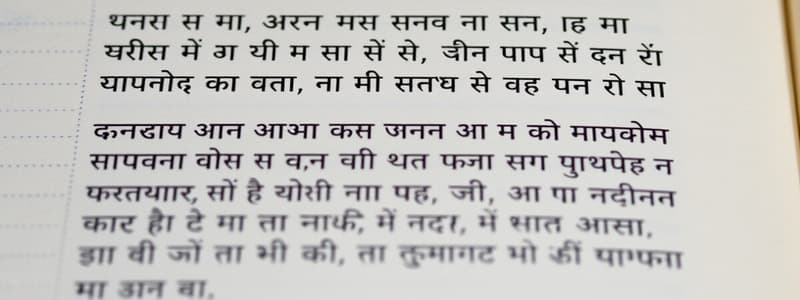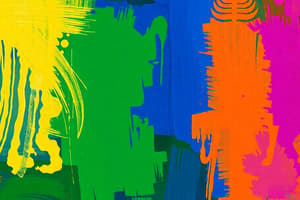Podcast
Questions and Answers
What is the earliest form of Sanskrit found in the Vedas?
What is the earliest form of Sanskrit found in the Vedas?
- Vedic Sanskrit (correct)
- Liturgical Sanskrit
- Modern Sanskrit
- Classical Sanskrit
What writing system is used for Sanskrit?
What writing system is used for Sanskrit?
- Latin
- Cyrillic
- Devanagari (correct)
- Arabic
Which of the following is a key concept emphasized in Sanskrit literature?
Which of the following is a key concept emphasized in Sanskrit literature?
- Nirvana
- Anarchy
- Chaos
- Dharma (correct)
How many genders are present in Sanskrit grammar?
How many genders are present in Sanskrit grammar?
Sanskrit contributed to the development of which of the following modern languages?
Sanskrit contributed to the development of which of the following modern languages?
Flashcards are hidden until you start studying
Study Notes
Overview of Sanskrit
- Ancient Indo-Aryan language.
- Considered the liturgical language of Hinduism, Buddhism, and Jainism.
- One of the oldest languages in the world.
Historical Development
- Originated around 1500 BCE, part of the Indo-European language family.
- Earliest form is Vedic Sanskrit, found in the Vedas.
- Classical Sanskrit emerged around 500 BCE, standardized by Panini's grammar.
Characteristics
- Highly inflected language with a complex system of morphology.
- Uses a phonetic writing system known as Devanagari.
- Rich vocabulary with numerous synonyms and a vast array of compounds.
Literary Significance
- Home to a vast body of literature, including epics (Mahabharata, Ramayana), philosophical texts (Upanishads), and poetry.
- Emphasizes dharma (duty), karma (action), and moksha (liberation).
Grammar
- Extensive grammatical rules with eight cases (vibhaktis).
- Three genders: masculine, feminine, and neuter.
- Verbs are conjugated based on tense, mood, and person.
Influence
- Contributed to many modern languages in India and influenced languages such as Thai, Khmer, and Tibetan.
- Provides roots for many scientific, technical, and philosophical terms used in various fields today.
Current Status
- Considered a "classical" language today, with limited use in daily conversation.
- Taught in educational institutions and studied for its cultural and historical significance.
Overview of Sanskrit
- Ancient Indo-Aryan language central to the spiritual texts of Hinduism, Buddhism, and Jainism.
- Recognized as one of the world's oldest languages, showcasing a rich historical and cultural legacy.
Historical Development
- Dates back to approximately 1500 BCE, falling within the broader Indo-European language family.
- Vedic Sanskrit, the earliest form, is documented in ancient scriptures called the Vedas.
- Transitioned to Classical Sanskrit around 500 BCE, with grammar formalized by the grammarian Panini, marking a significant evolution in linguistic precision.
Characteristics
- Notably a highly inflected language featuring a complex morphological structure.
- Utilizes Devanagari script, a phonetic writing system that represents sounds clearly.
- Possesses an extensive vocabulary with many synonyms and a rich variety of compound words, enhancing expressiveness.
Literary Significance
- Encompasses a massive corpus of literature, including prominent epics like the Mahabharata and Ramayana, and profound philosophical texts such as the Upanishads.
- Key themes revolve around concepts like dharma (duty), karma (action), and moksha (liberation), which are fundamental to its literary works.
Grammar
- Comprised of extensive grammatical rules that include eight cases (vibhaktis) for noun declension.
- Features three grammatical genders: masculine, feminine, and neuter, influencing verb conjugation.
- Verbs are conjugated based on various parameters including tense, mood, and person, adding layers to sentence structure.
Influence
- Sanskrit has significantly influenced various modern languages in India and beyond, including Thai, Khmer, and Tibetan.
- Serves as the root language for numerous scientific, technical, and philosophical terms across diverse fields today.
Current Status
- Regarded as a "classical" language, with limited everyday conversational use in contemporary society.
- Actively taught in educational institutions, studied primarily for its cultural, historical, and linguistic importance.
Studying That Suits You
Use AI to generate personalized quizzes and flashcards to suit your learning preferences.




